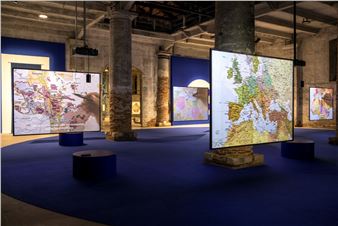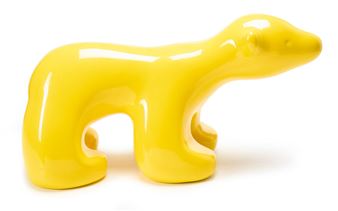Birthday Hat
Printmaking as a manual method of printing process is an art form that continually benefits and loses from the deep tradition and legacy of many personalities in our local environment. On the one hand these conditions provide the background and experience of many artists, schools and workshops, but on the other hand they seem to surround everything that follows up on them with a transparent but hard-to-perforate bubble that exists separately from the scene of contemporary exhibitions that respond to trends and social actions. This ahistorical aura is a filter, communicating with a specific part of the audience, but it is also a secret that shrouds working methods known only to a coterie of insiders. Czech printmaking is independent, content in its nerdiness, and doesn’t even need the rapidly changing contemporary art scene. But what if, after years of fishing for new ground in the weirdest waters of visual culture and traditional crafts, the contemporary scene needs printmaking?
This question is not a dogma, but an exaggeration that allows us to explore how prints can function without the obligatory museum installation and be read in a space that is not just an exhibition gallery, but a complex environment that influences the experience and perception of the whole and the individual prints. For the same reason, the exhibition is focused on the technique of intaglio printing, which is generally perceived with the greatest amount of archaism. When considering etchings, aquatints and drypoint (although the exhibition also includes mezzotints, photogravures and intaglio prints from lithographic stone), the discussion of the exhibition naturally turned to Francisco Goya. His prints and paintings work with darkness to perfection, but he also, according to his famous self-portrait at his easel, worked by the light of candles waxed to the brim of his hat. This detail of his working environment, and by extension his creative process, is one of the reasons why Goya’s graphic cycles have been installed in recent years in very shadowy rooms with minimal spot lighting. At the same time, it makes us wonder to what extent this method of installation, meaning the most perfect transfer of the artist’s creative conditions, would enrich the perception of the work once it has been moved into the exhibition space.
Although the exhibition does not deny a certain desire to break some conventions, it does not aim to categorize or map the graphic scene in any way. The choice of the exhibiting artists was mainly determined by the chain of personal contacts, the community around Studio Prám and the intention to exhibit interesting prints by students who have independently of their specialization worked at the Graphic Workshop of the Academy of Fine Arts in Prague.
The hat with glued-on candles is, in addition to serious debates with a possible social overlap about the artist life, also a witty costume accessory, enticing to pop culture interpretation. It defines the material and lighting conditions of the installation of the prints while resembling a humorous party hat for a birthday celebration.

Recommended for you
Printmaking as a manual method of printing process is an art form that continually benefits and loses from the deep tradition and legacy of many personalities in our local environment. On the one hand these conditions provide the background and experience of many artists, schools and workshops, but on the other hand they seem to surround everything that follows up on them with a transparent but hard-to-perforate bubble that exists separately from the scene of contemporary exhibitions that respond to trends and social actions. This ahistorical aura is a filter, communicating with a specific part of the audience, but it is also a secret that shrouds working methods known only to a coterie of insiders. Czech printmaking is independent, content in its nerdiness, and doesn’t even need the rapidly changing contemporary art scene. But what if, after years of fishing for new ground in the weirdest waters of visual culture and traditional crafts, the contemporary scene needs printmaking?
This question is not a dogma, but an exaggeration that allows us to explore how prints can function without the obligatory museum installation and be read in a space that is not just an exhibition gallery, but a complex environment that influences the experience and perception of the whole and the individual prints. For the same reason, the exhibition is focused on the technique of intaglio printing, which is generally perceived with the greatest amount of archaism. When considering etchings, aquatints and drypoint (although the exhibition also includes mezzotints, photogravures and intaglio prints from lithographic stone), the discussion of the exhibition naturally turned to Francisco Goya. His prints and paintings work with darkness to perfection, but he also, according to his famous self-portrait at his easel, worked by the light of candles waxed to the brim of his hat. This detail of his working environment, and by extension his creative process, is one of the reasons why Goya’s graphic cycles have been installed in recent years in very shadowy rooms with minimal spot lighting. At the same time, it makes us wonder to what extent this method of installation, meaning the most perfect transfer of the artist’s creative conditions, would enrich the perception of the work once it has been moved into the exhibition space.
Although the exhibition does not deny a certain desire to break some conventions, it does not aim to categorize or map the graphic scene in any way. The choice of the exhibiting artists was mainly determined by the chain of personal contacts, the community around Studio Prám and the intention to exhibit interesting prints by students who have independently of their specialization worked at the Graphic Workshop of the Academy of Fine Arts in Prague.
The hat with glued-on candles is, in addition to serious debates with a possible social overlap about the artist life, also a witty costume accessory, enticing to pop culture interpretation. It defines the material and lighting conditions of the installation of the prints while resembling a humorous party hat for a birthday celebration.
Contact details















